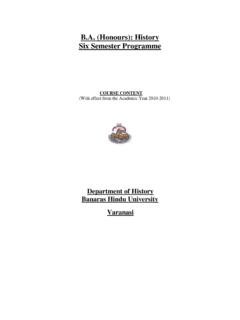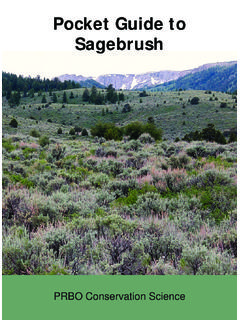Transcription of BANARAS HINDU UNIVERSITY SYLLABI B.Sc. (Hons.) …
1 BANARAS HINDU UNIVERSITY . SYLLABI . (Hons.) Courses Offered by FACULTY OF SCIENCE. 2012--13). (Effective from 2012. Course content: (Hons.). Sl. No. Courses Department/ Subject Page No. 1. (Hons.) Botany 3 13. 2. (Hons.) Chemistry 14 31. 3. (Hons.) Computer Science 32 40. 4. (Hons.) Geography 41 59. 5. (Hons.) Geology 60 73. 6. (Hons.) Home Science 74 94. 7. (Hons.) Mathematics 95 109. 8. (Hons.) Physics 110 122. 9. (Hons.) Statistics 123 136. 10. (Hons.) Zoology 137 168. 11. Industrial Microbiology 169 -174. -2- BANARAS HINDU UNIVERSITY . Department of Botany Faculty of Science SYLLABI . (Hons.) Programme in Botany -3- B. Sc. (HONS.) BOTANY. DISTRIBUTION OF DIFFERENT COURSES AND CREDITS IN VARIOUS SEMESTERS.
2 Semester-I. Course Code Title Credits BOB101 Cryptogams 4. BOB102 Lab. work based on Course BOB101 2. Total 6. Semester-II. Course Code Title Credits BOB201 Microbiology, Plant Pathology, Cytology and Genetics 4. BOB202 Lab. work based on Course BOB201 2. Total 6. Semester-III. Course Code Title Credits BOB301 Plant Ecology and Physiology 4. BOB302 Lab. work based on Course BOB301 2. Total 6. Semester-IV. Course Code Title Credits BOB401 Phanerogams 4. BOB402 Lab. work based on Course BOB401 2. Total 6. Semester-V. Course Code Title Credits BOB501 Comparative studies of Cryptogams 4. BOB502 Comparative studies of Phanerogams 4. BOB503 Plant Ecology and Toxicology 4. BOB504 Lab. work based on Course BOB501 2.
3 BOB505 Lab. work based on Course BOB502 2. BOB506 Lab. work based on Course BOB503 2. BOB 507 Field Study 4. Total 22. -4- Semester-VI. Course Code Title Credits BOB601 Plant Metabolism, Biochemistry and Biotechnology 4. BOB602 Microbiology and Plant Pathology 4. BOB603 Cytogenetics and Evolutionary Processes 4. BOB604 Lab. work based on Course BOB601 2. BOB605 Lab. work based on Course BOB602 2. BOB606 Lab. work based on Course BOB603 2. BOB607 Dissertation based on review 4. Total 22. Grand Total 68. -5- (HONS.) BOTANY. SEMESTER - I. BOB101: CRYPTOGAMS Credits: 4. General classification of Cryptogams; study of structure, reproduction and life history of the following representative forms included in various groups Section A: Algae 1.
4 General characteristics of Chlorophyceae, Xanthophyceae, Phaeophyceae, Rhodophyceae and Cyanophyceae 2. Chlorophyceae: Volvox, Oedogonium, Draparnaldiopsis 3. Xanthophyceae: Vaucheria 4. Phaeophyceae: Ectocarpus, Sargassum 5. Rhodophyceae: Polysiphonia 6. Cyanophyceae: Nostoc, Scytonema Section B: Fungi 1. General characteristics of Mastigomycotina, Zygomycotina, Ascomycotina, Basidiomycotina and Deuteromycotina 2. Mastigomycotina: Saprolegnia, Albugo 3. Zygomycotina: Rhizopus 4. Ascomycotina: Peziza 5. Basidiomycotina: Agaricus, Puccinia 6. Deuteromycotina: Alternaria, Cercospora Section C: Bryophytes 1. General characteristics of Hepaticopsida, Anthocerotopsida and Bryopsida 2. Hepaticopsida: Marchantia 3.
5 Anthocerotopsida: Anthoceros 4. Bryopsida: Funaria Section D: Pteridophytes 1. General characteristics of Psilophyta, Lycophyta, Sphenophyta and Filicophyta; Various types of steles 2. Lycophyta: Selaginella 3. Sphenophyta: Equisetum 4. Filicophyta: Pteris BOB102: Lab. work based on Course BOB101 Credits: 2. Suggested readings: 1. Gangulee, and Kar, , College Botany Vol. II- 2011 (Algae+Fungi+Brophyta+. Pteridophyta), New Central Book Agency, Kolkata 2. Singh, Pande, Jain, A Text Book of Botany, 2010 (Algae+Fungi+Brophyta+Pteridophyta) , Rastogi Publication, Meerut 3. Rashid, A., An Introduction to Pteridopyta by, 2nd edition, 2011 (Reprint), Vikas Publishing House Pvt. Ltd., Noida. 4. Lee, , 2008, Phycology, Cambridge UNIVERSITY Press, Cambridge -6- SEMESTER - II.
6 BOB 201: MICROBIOLOGY, PLANT PATHOLOGY, CYTOLOGY and GENETICS. Section A: Microbiology and Plant Pathology Credits: 4. 1. History and scope of Microbiology 2. Position of microorganisms in the living world; morphological, metabolic and molecular criteria for the classification of bacteria (scheme not required). 3. Structure of a bacterial cell: flagella, cell envelope, cell membrane, chromosome, plasmid and endospore 4. Structure of bacteriophages T4 and Lambda; Lysogenic and lytic cycles 5. A brief account of genetic recombination in bacteria (transformation, conjugation and transduction). 6. Role of microorganisms in cycling of nitrogen. 7. Microorganisms and the production of wines and antibiotics 8.
7 General symptoms and control measures for the following plant diseases: Late blight of potato, Wilt of Cajanus cajan, Loose smut of Wheat, Covered smut of Barley, Citrus canker, TMV. Suggested readings: 1. Prescott, Harley and Klein's Microbiology 7th edition (2008). Mc GRAW Hill. Singapore 2. Brock Biology of Microoranisms, 13th edition (2012). 3. Stainier, General Microbiology 5th edition (2009) Mc Millan Press Ltd., Hound Mills 4. Singh, Plant diseases, 9th edition (2009). Oxford and IBH Pub. Co. Pvt. Ltd., New Delhi Section B: Cytology and Genetics 1. Basic tenets of cytogenetics: cell and cell theory, germplasm theory. 2. Ultrastructure of plant cell: Nucleus, cytoskeleton 3. Cell cycle: Euchromatin and heterochromatin, mitosis, meiosis; genetic significance of meiosis 4.
8 Mendel's laws of inheritance: Law of segregation, law of independent assortment, deviations from Mendel's laws (Neo-Mendelism). 5. Interaction of genes: Intragenic and intergenic interactions, incomplete dominance, lethal genes, complementary genes, supplementary genes, inhibitory genes, duplicate genes, epistatic genes 6. Linkage and crossing over: Interrelationships and importance, crossing over and meiosis, cytological basis of crossing over, crossing over and linkage map. 7. Sex determination: Bases of sex determination, chromosome theory of sex determination, sex determination in plants 8. Synthetic theory of evolution Suggested readings: 1. Gardner, Simmons and Snustad, John, Principles of Genetics Wiley & Son, India 2.
9 Gupta, , A Text Book of Cytology, Genetics and Evolution, , Rastogi Publication, Meerut 3. Robertis, De and Robertis, De Cell and Molecular Biology, Pub. Walters Kluwer (India) Pvt. Ltd. BOB 202: Lab. work based on Course BOB 201 Credits: 2. -7- SEMESTER - III. BOB 301: PLANT ECOLOGY AND PHYSIOLOGY Credits: 4. Section A: Ecology 1. Introduction to ecology 2. Abiotic environment: Atmosphere, Temperature, Water, Light and Soil (structure and soil profile). 3. Biotic environment: Interaction between plants, animals and man; Interactions among plants growing in a community; Interactions among plants and microorganisms 4. Plant adaptations in response to water availability 5. Population ecology: Population characteristics (Density, Dispersion, Age structure, Natality, Mortality Survivorship curves, Growth curves), Ecotypes and Ecads 6.
10 Community Ecology: Analytical and Synthetic characters (Frequency, Density, Cover, IVI, Life forms, Biological spectrum, Phenology, Sociability). 7. Ecosystem ecology: Ecosystem structure (abiotic and biotic components, food chain (Grazing and Detritus), food web, ecological pyramids; ecosystem function (models of energy flows), biogeochemical cycles (carbon and phosphorus). 8. Ecological succession: General process, Mechanism and pattern (Hydrosere and Xerosere), Types and pattern Suggested reading: 1. Odum and Barrett, Thomson, Ed. Brooks/Cole, Fundamentals of Ecology, Cengage Learning 2. Singh, Singh and Gupta Ed., Ecology, Environment and Resources Conservation, , Anamaya Pub., New Delhi 3. Odum, , Basic Ecology, Ed.)

















